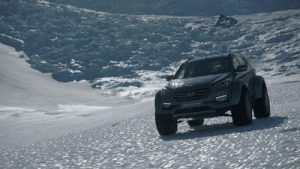
Shackleton Returns: Hyundai Santa Fe conquers the Antarctic driven by Great Grandson of Sir Ernest Shackleton. (CNW Group/Hyundai Auto Canada Corp.)
The 30-day route, which was driven in a Hyundai Santa Fe, traversed the continent from Union Camp to McMurdo and back again, completing the journey that Shackleton began more than 100 years ago.
The 30-day expedition saw Bergel and a small team take on almost 5,800 kilometres of icy terrain in bitter conditions. They not only had to cover extreme distances at temperatures down to minus 28-degrees Celsius but also had to plot new paths on floating ice caps that have never been travelled by wheeled vehicle before.
“I’m not a polar explorer; I’m an indoor guy,” said Bergel, who works as a technology entrepreneur. “So, it was a big cultural shift – and it was quite something to have been the first to do this. Getting to the South Pole was a special moment. The fact that this was a place my great grandfather tried to get to more than once and I was there, it felt like a genuine connection.
“What we did though was one thousandth as hard as what they did. You know, no comparison – modern appurtenances, comparative luxury. But it was an amazing journey, and an amazing achievement.”
The expedition was inspired by Shackleton’s heroic Trans-Antarctic journey of 1914-17 when, having been beaten to the Pole by Roald Amundsen, he tried to become the first to cross the continent. His ship sank in pack ice, but the heroic explorer and five men sailed 1,287 kilometres over open, stormy sea to South Georgia, from where a successful rescue could be launched.
It was this spirit of endurance shown by Shackleton that inspired Hyundai Motor to visit the Antarctic and enable a member of Shackleton’s family to complete what had been started by Sir Shackleton.
Original artefacts from that expedition were too fragile and precious to be taken by Bergel on this expedition – so he opted for a far more modern solution.
“There was a compass but unfortunately it is uninsurable and the first editions, memoirs and so on were not very Antarctic-friendly,” said Bergel. “So, I took the diaries with me…on a Kindle! They were fascinating and it meant much more than just reading them in London [England].”

Photo: (CNW Group/Hyundai Auto Canada Corp.)
The journey was carefully plotted on GPS and locations of potential danger areas were reviewed in detailed meetings with experts at Union Glacier before departure but there were still plenty of pitfalls along the way.
“When you’re driving through a total white-out you start hallucinating, seeing things that aren’t there,” said Bergel. “Our brains often confused us into believing we were going uphill rather than down. In one area, a giant crevasse field, we had to rope up the vehicles to make sure if one fell in it could be recovered by the others. We had one scary moment there – but we managed to get through ok.”
One of Antarctica’s most experienced driving experts, Gisli Jónsson from Arctic Trucks was tasked with managing the vehicle’s preparation before the event and then led the expedition out in the Antarctic. “People who have a lot of experience of Antarctica know what it does to machinery: basically, anything and everything falls apart,” said Jónsson. “Even the big machines crack up and break apart. This was the first time this full traverse has ever been attempted, let alone doing it there and back. A lot of people thought we would never ever make it and when we returned they couldn’t believe we’d actually done it!”
The expedition has been made into a short film by Hyundai. It can be viewed at https://www.youtube.com/watch?v=J01mqggN0h8&feature=youtu.be
